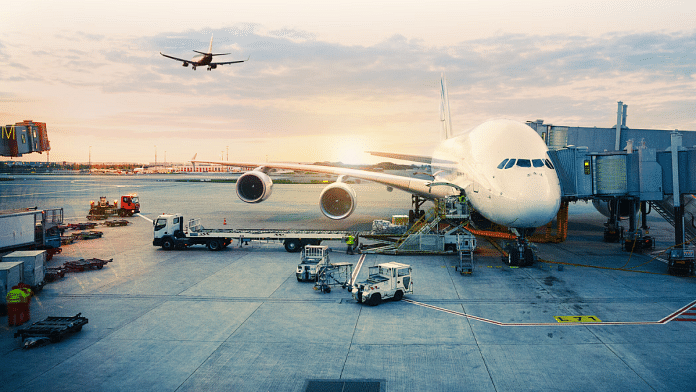Aviation is a tough industry to decarbonize, not least because efficiency gains need to keep pace with increasing air traffic demand.
With air traffic projected to double by 2042 from around 12 billion passengers a year, net-zero aviation, currently targeted for 2050, feels a long way off. Recent data from the environmental group Transport & Environment reveals that emissions from European airline flights will be 4% above 2019 levels by the end of December 2025 – further evidence of the challenge to decarbonize.
“Nobody in the industry can wave a magic wand or work very hard and accomplish carbon neutrality or sustainability by themselves. They really need to have everybody in the industry working collaboratively,” Justin Erbacci, director general of Airports Council International World, told Radio Davos.
There are many ways to reduce the climate impact of flying; some can be adopted almost immediately, such as using more and better-quality sustainable aviation fuel (SAF), an alternative jet fuel that reduces carbon emissions by up to 80% on a lifecycle basis.
Others will take more time, such as aircraft powered by batteries, which could materialize within the next decades or hydrogen, which has the potential to power larger, longer-distance flights in the longer term.
Of all the challenges highlighted in the recent Global Aviation Sustainability Outlook 2025 – which collates insights from top aviation executives, there is one in particular that stands out in the short term: the availability and cost of SAF.
The SAF bottleneck
It is a chicken-and-egg problem. While there may be demand for SAF from airlines, supply is limited and prices are projected to remain two to three times higher than jet fuel until 2030. However, it will be hard to boost production and reduce production costs without reaching greater scale.
SAF producers need to be confident that demand will continue to grow and need long-term offtake agreements to obtain the necessary funding to build production facilities from financiers.
According to Paul Griffiths, chief executive officer of Dubai Airports, “The global jet fuel market is worth around $254 billion per year, with SAF representing just 0.7% of total fuel production.”
If SAF production doubles every two years, he says, it would still take over seven and a half years for 10% of total jet fuel to come from sustainable sources.
“It’s a very big problem. It needs a big solution, and it needs huge investment,” says Griffiths.
“Industry and governments have got to work together to create a level playing field of investment that doesn’t incentivize poor behaviour.” He notes that one solution would be a levy on aviation fuel or ticket prices, such as the scheme recently applied in Singapore, where just under $2 per passenger is channelled towards SAF production.
Although it would result in “justifiable” costs being passed on to the consumer, he says “We could actually solve the problem if that was applied on a global basis.” Recently, the UK government also proposed a levy on fossil jet fuel to fund local SAF production.
High-stakes need for policy alignment
The introduction of new measures and regulations to support SAF by an increasing number of countries strengthens the importance of international standards and policy consistency.
To encourage investment and consistent SAF adoption worldwide, SAF policies benefit from international alignment and any subsidies to incentivise their production must provide long-term clarity to investors. If countries don’t act in unison in these areas, policy effectiveness will suffer.
Ayesha Choudhury, chief commercial officer at Infinium – a market leader in ultra-low carbon synthetic efuels – says “policy certainty” is key: “predictable revenue… that’s enabled by policy certainty… is really important for off-takers to be able to commit to the long- term agreements that are necessary to get the plants built.”
A great risk is that geopolitical headwinds can slow down aviation decarbonization efforts. Increasing protectionism and tariffs are sparking particular concern among aviation executives.
Geopolitical tensions are destabilizing exports of feedstock, the raw material for SAF, as well as fuelling domestic energy security concerns. With supply chains under stress, feedstock prices are rising, further squeezing the margins of active SAF plants and affecting their production outlooks.
In addition to political risks, magnified by last year’s “super elections” that threaten to shift government priorities and lead to policy reversals, there are also economic ones.
Despite lower inflation and strong growth in the aviation sector, with revenues exceeding $1 trillion for the first time this year, the global economic outlook remains a concern for aviation executives, particularly in emerging markets.
Net zero is within reach
Route closures, rising labour costs, supply chain bottlenecks and regulatory uncertainty are impacting profitability and could divert the sector’s focus from the net-zero agenda.
This is a critical moment for the aviation industry. Updated state action plans for decarbonization are due to be submitted to the International Civil Aviation Organisation by September, as stakeholders try to walk the fine line between accelerating decarbonization and boosting the sector’s growth in the wake of COVID-19.
Actions taken now will determine the viability of internationally agreed targets, such as reducing the carbon intensity of jet fuel by 5% by 2030.
Achieving net-zero aviation by 2050 is well within our collective grasp. SAF will undoubtedly play a key role in this journey, especially in the short to medium term. But it will not, by itself, be enough.
As other technologies become increasingly available, swift and concerted action – from governments and regulators to airports, airlines and businesses along the wider value chain – will be critical.
Over the last 25 years, aviation has laid the groundwork for its sustainable transition, marked by increasing collaboration between governments and the industry. This must continue to help aviation reach net zero by 2050.
This article is republished from the World Economic Forum under a Creative Commons license. Read the original article.






